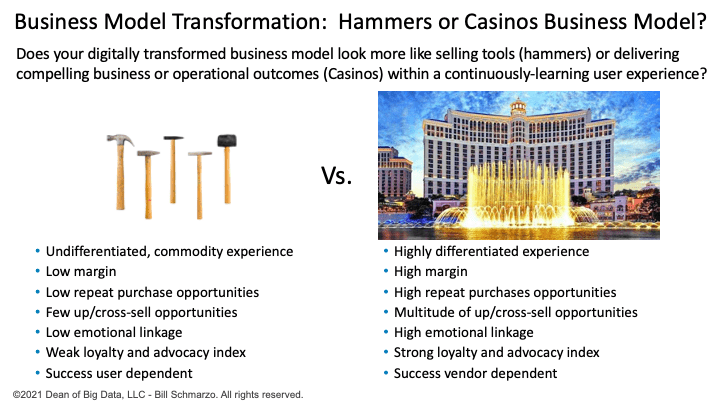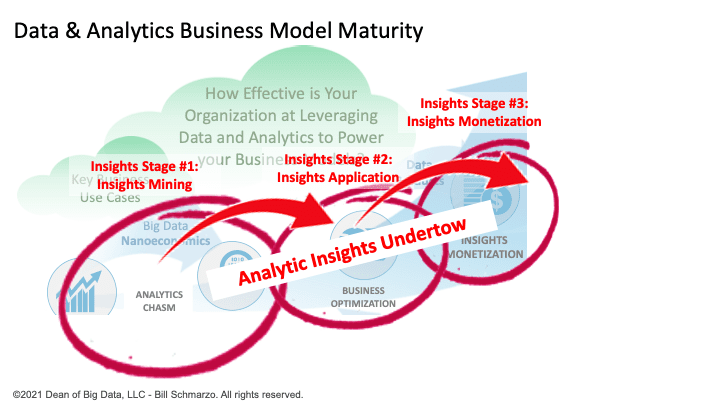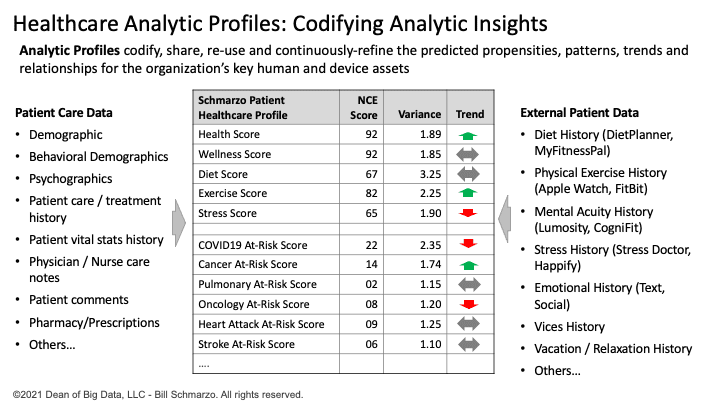
We are in the middle of a business model revolution. And we are active participants in that revolution. We have been transitioning from a society where possession and application of physical commodities defined wealth and power, to a society where possession and application of knowledge define wealth and power.
Throughout the 20th century, oil had been the most valuable commodity in defining wealth and power. Possession and application of oil defined the fortunes of individuals (John D. Rockefeller, H.L. Hunt, Paul Getty), companies (Standard Oil, ExxonMobil, Shell, BP), and countries (United States, Russia, Saudi Arab, Iraq, Canada, Venezuela). Countries even went to war over oil (watch out Canada).
Today, wealth creation has transitioned to companies (Google, Meta, Apple, Amazon, Microsoft) and individuals (Jeff, Steve, Larry, Sergey, Mark, Bill, Elon) who possess and apply customer, product, service, and operational knowledge to power superior business and operational outcomes via a continuously-learning customer experience (Figure 1).

Figure 1: History of the World’s Most Valuable Companies
Today’s leading companies are exploiting the economic characteristics of knowledge or insights (where insights are predictive behavioral and performance propensities at the individual human or device entity level) gleaned using data and analytics – digital assets that not only can be used across an unlimited number of use cases at zero marginal cost, but can also continuously-learn, adapt, and refine to become more valuable the more that they are used.
But let’s be clear about what differentiates today’s business model transformation. Those companies that are thriving during this business model transformation aren’t in the tools business. They are in the knowledge business.
Hammers versus Casinos Business Model
These transformational companies – plus others such as Uber, Netflix, Spotify, American Express, and Wealthfront – are in the business of uncovering, codifying, and leveraging customer, product, service, and operational knowledge (predictive behavioral and performance propensities) that deliver superior business and operational outcomes through a more compelling, continuously-learning customer experience.
These companies are not in the tools business. They are more similar to the zodiac casino review business, a business that derives and drives value by leveraging customer, service, and operational knowledge to create a more compelling, continuously-learning customer experience (Figure 2).

Figure 2: What is Your Digital Transformation Business Model
Surprisingly, many of these companies that are digitally transforming their business models do make tools, but they then open-source those tools versus selling them. For example:
- Google has created several valuable, open-source tools including Android (an open-source operating system based designed primarily for an array of devices with different form factors), TensorFlow (an end-to-end open-source platform for machine learning), Keras (which provides a Python interface for artificial neural networks), and MapReduce (programming model used to access big data stored in the Hadoop File System).
- Facebook is an example of another company that has created and then open-sourced many powerful tools including Presto (distributed SQL query engine for running interactive analytic queries), Cassandra (distributed, wide-column store, NoSQL database management system), and Hive (distributed, fault-tolerant data warehouse system).
- LinkedIn has made several open-source tool contributions including Apache Kafka (distributed event store and stream-processing platform), Voldemort (Distributed key-value store), and Pinot (real-time distributed OLAP store).
- Yahoo has made open-source tool contributions including Apache Hadoop (using a network of many computers to solve problems involving massive amounts of data and computation) and Vespa (a full-featured text search engine that supports both regular text search and fast approximate vector search).
And why do these leading companies give away these powerful “tools”? Let’s review Google’s decision to open-source TensorFlow to understand a key aspect of organizations that are digitally transforming their business models.
Business Model Transformation Key #1: Exploiting Economies of Learning
Google uses TensorFlow to power many of its most profitable services including Personal Photo App (it auto-magically groups your photos into storyboards or collages), recognize spoken words (natural language processing), translate foreign languages (handy for me as I frequently travel internationally), and its search engine. Arguably, TensorFlow is the foundation for everything that makes Google money.
So, why would Google open-source this incredibly valuable tool?
From the Forbes article “Reasons Why Google’s Latest AI-TensorFlow is Open Sourced”, we get this valuable insight (maybe the most important lesson in digitally transforming one’s business model):
“In order to keep up with this influx of data and expedite the evolution of its machine learning engine, Google has open sourced its engine TensorFlow.”

Figure 3: “Economic Value of Learning and Why Google Open Sourced TensorFlow”
Google open-sourced TensorFlow to gain tens of thousands of more users across thousands of new use cases so that TensorFlow could learn and improve the predictive effectiveness of the platform that runs Google’s business. Google knows that they are in the knowledge business and understands that the “economies of learning” are more powerful than the “economies of scale.”
So, we understand that the source of economic value isn’t in the tools. And shockingly, the source of economic value isn’t in the data. The true source of economic value is in applying the tools to one’s data to uncover, codify, and leverage customer, product, service, and operational predictive insights.
Business Model Transformation Key #2: Insights Monetization
The Data & Analytics Business Model Maturity Index provides a roadmap and guide to help organizations to become more effective at leveraging data and analytics to power their business models. And underpinning the Data & Analytics Business Model Maturity Index is a powerful Analytic Insights Undertow driven by the organization’s ability to 1) mine, 2) apply, and 3) monetization individualized customer, product, service, and operational predictive insights (Figure 4).

Figure 4: Analytics Insight Powerful Undertow
The Analytics Insights Undertow powering the Data & Analytics Business Model Maturity Index is comprised of 3 stages:
- Stage 1: Insights Mining. On a use case-by-use case basis (a best practice approach that we’ll discuss later), we can apply AI / ML to mine (or uncover), codify and capture the individualized human or device analytic insights (predictive behavioral and performance propensities).
- Stage 2: Insights Application. We can then apply the individualized analytic insights to optimize the organization’s key business and operational use cases that deliver a meaningful, quantifiable ROI for each use case.
- Stage 3: Insights Monetization. We can leverage the customer, product, and operational insights to create new revenue opportunities (such as new products, services, audiences, channels, markets, partnerships, consumption models, etc.) and new data products that open up and expand the organization’s total addressable market.
To support the Analytic Insights Undertow, we use Analytic Profiles to capture, share, and refine the individualized customer, product, service, and operational analytic insights or predictive propensities (Figure 5).

Figure 5: Analytic Profiles
Analytic Profiles provide a data model for capturing, codifying and sharing the analytic insights at the individual human or device level. These individualized analytic insights can include KPIs, predictive indicators, segments, analytic scores (think individualized credit score), features, and business rules that codify the behaviors, preferences, propensities, inclinations, tendencies, interests, associations, and affiliations of the organization’s key human or device business entities.
Business Model Transformation Key #3: Use Case-driven Execution
Use Cases are clusters of Decisions whose effectiveness is measured by Key Performance Indicators (KPIs) that drive the delivery of specific Business or Operational Outcomes.
A use case-by-use case approach for creating, sharing, and refining the organization’s data and analytic assets has the benefit of delivering measurable and meaningful financial and operational benefits more quickly. There is no need to wait for that data and analytics “big bang” project (and associated spend).
It is against the analytic insights (predictive propensities) stored in the Analytic Profiles that optimize the use cases that deliver superior business and operational outcomes (Figure 6).

Figure 6: Role of Analytic Profiles in Optimizing Business and Operational Use Cases
The focus on use cases as the driver of the organization’s business model transformation is both powerful (from a value creation perspective) and enabling (from an organizational alignment perspective). Why?
- Use cases are readily identifiable by the business stakeholders and subject matter experts (because they live them every day)
- Resolution or optimization of use cases is a source of quantifiable business and operational value (improving, reducing, or optimizing the use cases can have material business and operational value)
- A focus on use cases synergizes the collaboration between business stakeholders and the data science (data and analytics) team to define the objectives, benefits, value statements, and potential impediments of the use case, identify the metrics and KPIs against which use case progress and success will be measured, and codify the associated costs of use case False Positives and False Negatives (see “The Art of Thinking Like a Data Scientist” methodology).
- A use case-by-use case implementation approach provides an incremental, “pays for itself” approach to building out the organization’s data and analytic assets and capabilities (see the “Schmarzo Economic Digital Asset Valuation Theorem“).
Hammers or Casino Business Model Summary
In knowledge-based industries, the economies of learning are more powerful than the economies of scale. And soon, we’ll all be competing in knowledge-based industries.
We are transitioning from business models where possession and application of physical commodities defined wealth and power, to business models where possession and application of customer, product, service, and operational knowledge define wealth and power.
Key concepts behind this business model transformation include:
- Economies of Learning: accelerating the organization’s ability to continuously learn, adapt, and refine from both an AI / ML as well as a human perspective.
- Insights Monetization: understanding and exploiting the powerful Analytics Insights Undertow driven by the organization’s ability to 1) mine, 2) apply, and 3) monetization individualized customer, product, service, and operational predictive insights
- Use case-by-use case Execution: Driving the organization’s knowledge or predictive insights mining, application, and monetization process on a use case-by-use case basis that is a powerful enabler from both a value creation as well as organizational alignment perspective.
Do these things well (in addition to unleashing the creative and innovative capabilities of all your employees, something that I’ll discuss in my next blog), and you’ve earned the honor of being able to exploit all three effects that comprise the Schmarzo Economic Digital Asset Valuation Theorem to accelerate your digital transformation (Figure 7).

Figure 7: Schmarzo Economic Digital Asset Valuation Theorem
So, now you’ve got that going for you, which is nice.
